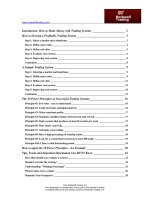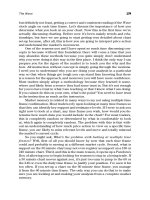Want to Make Money Fast Try These Trading Strategies
Bạn đang xem bản rút gọn của tài liệu. Xem và tải ngay bản đầy đủ của tài liệu tại đây (113.81 KB, 10 trang )
8
77
Want to Make Money
Fast? Try These
Trading Strategies
Many of the following strategies are popular with aggressive short-
term traders who want to make money quickly by taking advantage of
volatile stock prices. These traders primarily use technical analysis to
look for profitable trading opportunities, although some of them con-
firm their picks using fundamental analysis before buying or selling a
stock.
Day Trading: Buying and Selling in Minutes
Unlike investors, who may wait years before selling, day traders buy
and sell within seconds, minutes, or hours. Day trading is an extreme
trading strategy that involves constantly moving into and out of stocks.
Using technical analysis, professional day traders try to anticipate
where a stock will go in the near future and trade accordingly. Usually,
day traders sell all their stocks and move to cash by the end of each day.
CHAPTER
10381_Sincere_02.c 7/18/03 10:57 AM Page 77
Copyright © 2004 by The McGraw-Hill Companies, Inc. Click here for Terms of Use.
Day traders can trade from their home or trade stocks at a day trad-
ing firm, which provides high-speed telephone lines and customized
trading software. Although there have always been day traders, this
strategy became particularly popular during the late 1990s. In fact, so
many people were trading stocks from home that they were called
online traders.
An online trader can use a number of short-term strategies besides
day trading. For example, swing trading involves buying a stock early
in the week and selling it a few days later. Another short-term trading
strategy, called position trading, is to buy stock and hold it for a few
months. Some traders follow the trend of the market, buying when the
market is trending up and selling when the market is trending down.
Even with the best equipment and software, however, only a small
percentage of people are actually able to make money consistently by
day trading. First, it takes an incredible amount of discipline, trading
capital, and knowledge to be a successful day trader. Most people don’t
have the patience to sit by a computer all day and watch stock positions.
Although day traders can make money on occasion, it is an extremely
difficult game to play unless you have the power of a bull market
behind you. (It was no coincidence that just before the Nasdaq topped
out at 5000, thousands of people quit their jobs to become day
traders—a clear signal that things were going to end badly.)
Market Timing: A Controversial and Difficult Strategy
If you thought day trading was hard, imagine being a market timer.
With market timing, you predict in advance where a stock or the market
is headed. Then you make your move before the market does. For
example, if you believe that the market will rise in the next week, you
will shift your money out of cash or bonds and into stocks. The idea is
to shift your money to the most profitable investment before it goes up
(something that is easier said than done).
Market timing is a risky strategy that can cost you if you make the
wrong bet. To be a successful market timer, you have to know not only
when to get into the market, but also when to get out, which is why so
few traders are successful market timers. Timing the market is difficult
78
U
NDERSTANDING
S
TOCKS
10381_Sincere_02.c 7/18/03 10:57 AM Page 78
for most people. That hasn’t stopped people from trying, however. (You
could argue that even buy and hold is a form of market timing because
you are trying to time your purchase so that you buy low and sell high.)
Short the Rallies: The Opposite of Buy and Hold
A very effective, but rather risky, trading strategy is to short the rallies.
Instead of buying more stock when the market falls (buying on the dip),
you do the opposite: When the market or your stock goes up a lot, you
sell short (that is, you sell the stock, then buy it back at a lower price).
Shorting the rallies is extremely risky, although it worked quite well for
several years. After all, stocks go down faster than they go up.
Nevertheless, keep in mind that successfully shorting the rallies
takes a tremendous amount of time, skill, and patience. If you are
wrong and the stock keeps rising, it takes considerable discipline to buy
back the shares (called covering your position) for a small loss.
Exchange-Traded Funds: A Clever Way
to Spice Up Your Portfolio
Trading exchange-traded funds (ETFs) has recently become popular
with traders and investors, including many professionals. An ETF is an
investment product that is similar to a mutual fund, but that trades like
a stock. You can buy and sell ETFs on any major stock exchange just as
you would a stock. For as little as $500 you can buy an ETF that tracks
a specific index or sector. The most common ETFs are index funds,
such as the stocks that make up the Nasdaq 100 (QQQ), the S&P 500
(SPY), and the Dow Jones Industrial Average (DIA). Because of the
sudden popularity of these investments, new ETFs are being created all
the time. Just like those of stocks, prices of ETFs change continuously
during the day.
The advantage of trading ETFs is that they are cheap, liquid, and
tax-friendly. Because they consist of a basket of individual stocks,
ETFs provide instant diversification. After all, it would be too costly
WANT TO MAKE MONEY FAST
?
TRY THESE TRADING STRATEGIES
79
10381_Sincere_02.c 7/18/03 10:57 AM Page 79
and time-consuming to buy so many individual stocks on your own.
Because they are similar to stocks, you buy or sell ETFs through your
brokerage firm or Internet broker. Ultimately, it’s easy for both
investors and traders to find an ETF that meets their investment needs.
The disadvantages of trading ETFs are similar to those of trading
stocks. You pay a commission when you buy or sell. In addition, because
ETFs are relatively new, they haven’t much of a track record. Although
it takes time to learn how to trade ETFs successfully, it’s worth your time
to learn how this popular investment product works.
Trading on News
Like day trading, trading stocks based on the news is a difficult method
to play and win. It’s impossible to know how the market will react to
news about your stocks. There is a wise old saying: Buy on the rumor
and sell on the news. Often a stock will rise or drop in price in antici-
pation of a news event, such as an earnings release or a Fed meeting.
Once the news is released, however, the stock will go in the opposite
direction, which explains why it is so difficult to buy or sell stocks
based on what is in the news.
In reality, news is coming at you from dozens of different direc-
tions: newspapers, magazines, the Internet, television, and friends. The
hard part is figuring out which information is valuable and which
should be ignored. It’s amazing how wrong people (both professionals
and amateurs) have been about the market. Most of what people tell
you about the market is useless. Nevertheless, keep in mind that stocks
go up or down based on what people perceive to be the truth.
Some people deliberately try to influence the direction of stocks by
spreading false information about companies. A few years ago, a stock
could rise or fall based on nothing more than a well-placed rumor in an
Internet chat room. So many people lost money by trading on tips and
rumors that they stopped listening, at least temporarily. When the next
bull market appears (and it is likely to be a long wait), the scam artists
will crawl from beneath the rocks to lure unsuspecting investors into
losing money on stocks.
80
U
NDERSTANDING
S
TOCKS
10381_Sincere_02.c 7/18/03 10:57 AM Page 80
Trading Options
Although options are rather difficult to understand, with a little prac-
tice, they begin to make more sense. That’s why many professional
traders include option strategies in their portfolios. In particular, traders
will use options to hedge their position (taking the opposite side of a
trade to reduce risk). For example, if a trader is long a stock, he or she
might use options to short the same stock. While options can seem a bit
overwhelming even for experienced investors, I’ll do my best to explain
them so that they make sense.
Think of an option as a contract that gives you the right, but not the
obligation, to purchase or sell an item. It could be a house, a commod-
ity like oil or corn, or a stock. One type of stock option, for example,
gives you the right to purchase a particular stock at a given price by a
certain date. The wonderful part about options is that you don’t have to
own the stock to trade them. Options are also called derivatives because
their price comes from, or is derived from, the stock price.
The two most popular types of options are the call and the put. A
call option gives you the right to buy a stock at a specified price. A put
option allows you the right to sell a stock at a specified price. You have
the right to buy or sell the underlying stock, but most people don’t exer-
cise this right. They simply buy and sell the option. For a fraction of the
price, you can control hundreds or thousands of dollars worth of stock.
For example, let’s say Bright Light is selling for $20 a share. You
like Bright Light, and you think it will rise to $25 a share. So you
decide to buy a call option with a strike price of $25. (You can choose
any strike price. The further away the strike price is from the current
price, the cheaper the option. For example, an option with a $20 strike
price will be more expensive than one with a $25 strike price.) If Bright
Light does hit $25 or higher, you will be “in the money.” The higher the
stock goes, the more money you will make.
There is a catch, however. When you buy an option, you also have
to specify an expiration date, usually from 1 to 3 months from the date
of purchase. This means that Bright Light must rise to or above the strike
price before the expiration date or you will lose your entire investment.
WANT TO MAKE MONEY FAST
?
TRY THESE TRADING STRATEGIES
81
10381_Sincere_02.c 7/18/03 10:57 AM Page 81









